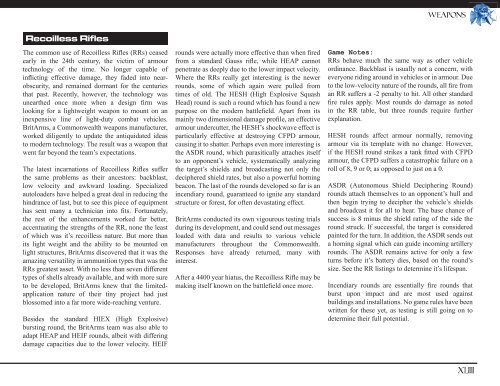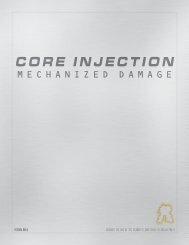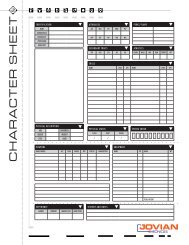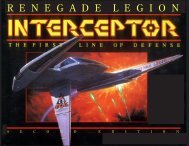renegadelegionneveren dingoffensive - Catsden.net
renegadelegionneveren dingoffensive - Catsden.net
renegadelegionneveren dingoffensive - Catsden.net
Create successful ePaper yourself
Turn your PDF publications into a flip-book with our unique Google optimized e-Paper software.
WEAPONS<br />
Recoilless Rifles<br />
The common use of Recoilless Rifles (RRs) ceased<br />
early in the 24th century, the victim of armour<br />
technology of the time. No longer capable of<br />
inflicting effective damage, they faded into nearobscurity,<br />
and remained dormant for the centuries<br />
that past. Recently, however, the technology was<br />
unearthed once more when a design firm was<br />
looking for a lightweight weapon to mount on an<br />
inexpensive line of light-duty combat vehicles.<br />
BritArms, a Commonwealth weapons manufacturer,<br />
worked diligently to update the antiquidated ideas<br />
to modern technology. The result was a weapon that<br />
went far beyond the team’s expectations.<br />
The latest incarnations of Recoilless Rifles suffer<br />
the same problems as their ancestors: backblast,<br />
low velocity and awkward loading. Specialized<br />
autoloaders have helped a great deal in reducing the<br />
hindrance of last, but to see this piece of equipment<br />
has sent many a technician into fits. Fortunately,<br />
the rest of the enhancements worked far better,<br />
accentuating the strengths of the RR, none the least<br />
of which was it’s recoilless nature. But more than<br />
its light weight and the ability to be mounted on<br />
light structures, BritArms discovered that it was the<br />
amazing versatility in ammunition types that was the<br />
RRs greatest asset. With no less than seven different<br />
types of shells already available, and with more sure<br />
to be developed, BritArms knew that the limitedapplication<br />
nature of their tiny project had just<br />
blossomed into a far more wide-reaching venture.<br />
Besides the standard HIEX (High Explosive)<br />
bursting round, the BritArms team was also able to<br />
adapt HEAP and HEIF rounds, albeit with differing<br />
damage capacities due to the lower velocity. HEIF<br />
rounds were actually more effective than when fired<br />
from a standard Gauss rifle, while HEAP cannot<br />
pe<strong>net</strong>rate as deeply due to the lower impact velocity.<br />
Where the RRs really get interesting is the newer<br />
rounds, some of which again were pulled from<br />
times of old. The HESH (High Explosive Squash<br />
Head) round is such a round which has found a new<br />
purpose on the modern battlefield. Apart from its<br />
mainly two dimensional damage profile, an effective<br />
armour undercutter, the HESH’s shockwave effect is<br />
particularly effective at destroying CFPD armour,<br />
causing it to shatter. Perhaps even more interesting is<br />
the ASDR round, which parasitically attaches itself<br />
to an opponent’s vehicle, systematically analyzing<br />
the target’s shields and broadcasting not only the<br />
deciphered shield rates, but also a powerful homing<br />
beacon. The last of the rounds developed so far is an<br />
incendiary round, guaranteed to ignite any standard<br />
structure or forest, for often devastating effect.<br />
BritArms conducted its own vigourous testing trials<br />
during its development, and could send out messages<br />
loaded with data and results to various vehicle<br />
manufacturers throughout the Commonwealth.<br />
Responses have already returned, many with<br />
interest.<br />
After a 4400 year hiatus, the Recoilless Rifle may be<br />
making itself known on the battlefield once more.<br />
Game Notes:<br />
RRs behave much the same way as other vehicle<br />
ordinance. Backblast is usually not a concern, with<br />
everyone riding around in vehicles or in armour. Due<br />
to the low-velocity nature of the rounds, all fire from<br />
an RR suffers a -2 penalty to hit. All other standard<br />
fire rules apply. Most rounds do damage as noted<br />
in the RR table, but three rounds require further<br />
explanation.<br />
HESH rounds affect armour normally, removing<br />
armour via its template with no change. However,<br />
if the HESH round strikes a tank fitted with CFPD<br />
armour, the CFPD suffers a catastrophic failure on a<br />
roll of 8, 9 or 0; as opposed to just on a 0.<br />
ASDR (Autonomous Shield Deciphering Round)<br />
rounds attach themselves to an opponent’s hull and<br />
then begin trying to decipher the vehicle’s shields<br />
and broadcast it for all to hear. The base chance of<br />
success is 8 minus the shield rating of the side the<br />
round struck. If successful, the target is considered<br />
painted for the turn. In addition, the ASDR sends out<br />
a homing signal which can guide incoming artillery<br />
rounds. The ASDR remains active for only a few<br />
turns before it’s battery dies, based on the round’s<br />
size. See the RR listings to determine it’s lifespan.<br />
Incendiary rounds are essentially fire rounds that<br />
burst upon impact and are most used against<br />
buildings and installations. No game rules have been<br />
written for these yet, as testing is still going on to<br />
determine their full potential.<br />
XLIII





